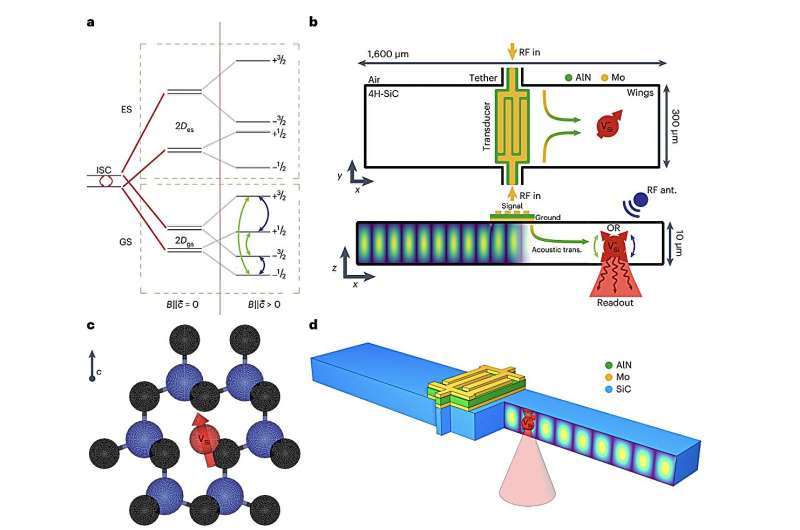October 20, 2023 feature
This article has been reviewed according to Science X's editorial process and policies. Editors have highlighted the following attributes while ensuring the content's credibility:
fact-checked
peer-reviewed publication
trusted source
proofread
A strategy for the spin-acoustic control of silicon vacancies in a 4H silicon carbide-based bulk acoustic resonator

Bulk acoustic resonators—stacked material structures inside which acoustic waves resonate—can be used to amplify sounds or filter out undesired noise. These resonators have found wide use in today's RF telecommunication, like Front-End Modules (FEM) in iPhones. They could also be valuable components for various cutting-edge scientific applications, including quantum technologies and imaging devices.
Despite their potential, precisely measuring the acoustic energy stored inside these devices over time has so far proved challenging. This limited their use for fabricating reliable and highly performing filters and signal processing devices.
Researchers at Harvard University and Purdue University recently set out to tackle this existing challenge in the field, by introducing a strategy to control and read-out silicon vacancies inside a bulk acoustic resonator based on 4H silicon carbide (SiC). Their proposed strategy, outlined in Nature Electronics, can be used to tune the frequencies amplified or absorbed by defects in 4H SiC with bulk acoustic resonators.
"Our research was motivated by studying the mechanical dynamics of a classical system with a quantum sensor," Jonathan R. Dietz, co-author of the paper, told Phys.org. "Notably our labs had already gathered resonators that could concentrate enough energy to study this interaction."
The recent study by Dietz and his colleagues builds on the researchers' previous research works. In their past papers, the researchers had introduced new acoustic resonators fabricated using 4H SiC, so-called lateral overtone bulk acoustic resonators (LOBARs). In addition, they demonstrated their potential, particularly as high quality-factor (Q) optical resonators.
"To accomplish the spin acoustic control of the silicon vacancies, we selected a device for high quality resonances and measured the spin-acoustic coupling with a confocal ODMR microscope," Dietz explained. "Finally, we used the measured spin resonance to precisely map out the acoustic waves in the LOBAR device."
As part of their study, the researchers demonstrated the potential of their proposed strategy for the spin-acoustic control of silicon vacancies in 4H SiC-based LOBAR devices. Dietz and his colleagues conducted a frequency spectrum analysis when the resonator was operating in its high Q mode using optical readout. In addition, they were able to produce a visualization of the device's resonance mode using 2D imaging tools that study the interaction between the resonator and defects in the material.
"Our measurement is non-invasive," Boyang (Alex) Jiang, co-author of the paper said. "Also, since the fluorescence is only related to the strain it couples to, our Q measured is the intrinsic Q of the SiC, without the need for de-embedding in RF measurement."
The new approach introduced by this team of researchers could be used to gather precise measurements inside LOBAR devices at ambient conditions and without interfering with their operation. In the future, it could be used to characterize the acoustic properties of various microelectromechanical systems, while also enabling greater control over quantum memory devices based on the spin defects that use acoustic vibrations as a quantum resource.
"Our study shows that a common, easily measurable defect in silicon carbide is mechanically sensitive and can be robustly controlled to make a non-invasive sensor of strain," Dietz said. "In our next studies we plan to realize the 3D imaging of the strain in SiC (silicon carbide)-based devices, like MRI. We would also like to use the feedback between resonator and spins to control both systems simultaneously."
More information: Jonathan R. Dietz et al, Spin-acoustic control of silicon vacancies in 4H silicon carbide, Nature Electronics (2023). DOI: 10.1038/s41928-023-01029-4
Journal information: Nature Electronics
© 2023 Science X Network





















